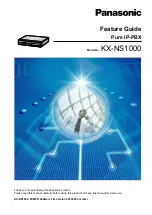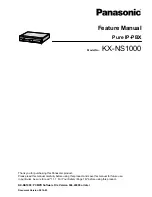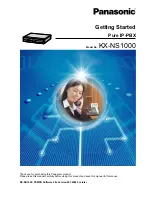
1.17.8 Built-in Simplified Voice Message (SVM)
Description
Installing an optional Simplified Voice Message (SVM/ESVM) card in the PBX allows the PBX to provide
answering machine features.
Features for an extension user with a message box:
An extension user can record a personal greeting message to greet a caller and ask him to leave a voice
message. The user can also play back and clear greeting messages and the voice messages left by callers.
Feature for a caller:
A caller can leave a voice message after hearing the greeting message.
For the KX-TDA30, an SVM2 card or ESVM2 card is required.
For the KX-TDA100/KX-TDA200/KX-TDA600, an ESVM2 or ESVM4 card on an OPB3 card is required.
SVM2 Card
Up to two SVM2 cards can be installed in the PBX. Each card is assigned a floating extension number (default:
591 for SVM card 1, and 592 for SVM card 2). A card has two channels, allowing two users to access a single
card at the same time.
When an extension is assigned to an SVM card through system programming, a message box is created for
that extension. This message box is used to store greeting messages and voice messages for the extension.
Each PT, SLT, and PS can be assigned its own message box.
[Example]
PBX
SVM Card 1: Floating Extension No. 591 (default)
SVM Card 2: Floating Extension No. 592 (default)
Message Box for
Extn. 101
Message Box for
Extn. 102
Message Box for
Extn. 103
Message Box for
Extn. 210
Message Box for
Extn. 301
2 CH
2 CH
ESVM2/ESVM4 Card
An ESVM card can be used either for the SVM feature, for the OGM feature (
®
(OGM)), or both.
An ESVM4 card (4 channels) contains two separate blocks of data, and is the equivalent of installing two
ESVM2 cards. Up to four ESVM cards (max. 16 channels) can be installed on each shelf of the PBX.
Only up to 2 cards (max. 8 channels) can be used for the SVM feature per system. In this case, each card is
assigned a floating extension number in the same way as an SVM2 card. The rest of the channels must be
used for OGM feature purposes.
When using an ESVM card for the SVM feature, it must be mounted on sub-slot 3 (highest slot) of the OPB3
card.
210
Feature Guide
1.17.8 Built-in Simplified Voice Message (SVM)
Содержание HYBRID IP-PBX KX-TDA200
Страница 15: ...Section 1 Call Handling Features Feature Guide 15...
Страница 37: ...PT Programming Manual References 720 Doorphone Call Destination Feature Guide 37 1 1 2 Internal Call Features...
Страница 91: ...User Manual References 1 2 1 Basic Calling Feature Guide 91 1 5 4 Trunk Call Features...
Страница 113: ...User Manual References 1 2 2 Easy Dialling Feature Guide 113 1 6 1 Memory Dialling Features...
Страница 141: ...User Manual References 2 1 3 Restriction Level Control Dial Tone Transfer Feature Guide 141 1 9 4 Dial Tone Transfer...
Страница 156: ...3 1 2 Settings on the Programming Mode 156 Feature Guide 1 11 4 Headset Operation...
Страница 159: ...Feature Guide References 1 20 2 Flexible Buttons Feature Guide 159 1 11 6 Flash Recall Terminate...
Страница 161: ...User Manual References 1 10 4 If a Host PBX is Connected Feature Guide 161 1 11 7 External Feature Access EFA...
Страница 175: ...User Manual References 1 4 2 Holding a Call Feature Guide 175 1 13 1 Call Hold...
Страница 290: ...Feature Guide References 3 1 Capacity of System Resources 290 Feature Guide 1 25 2 PS Ring Group...
Страница 323: ...1 11 1 Using the Telephones in a Hotel type Environment Hospitality Features Feature Guide 323 1 28 4 Timed Reminder...
Страница 368: ...2 1 7 Releasing Network Direct Station Selection NDSS Monitor 368 Feature Guide 1 30 5 QSIG Enhanced Features...
Страница 385: ...Section 2 System Configuration and Administration Fea tures Feature Guide 385...
Страница 430: ...430 Feature Guide 2 4 3 Local Alarm Information...
Страница 431: ...Section 3 Appendix Feature Guide 431...
Страница 456: ...456 Feature Guide 3 4 13 KX TDA30 PSMPR Software File Version 5 0xxx...
Страница 457: ...Index Feature Guide 457...
Страница 463: ...Feature Guide 463 Notes...



































